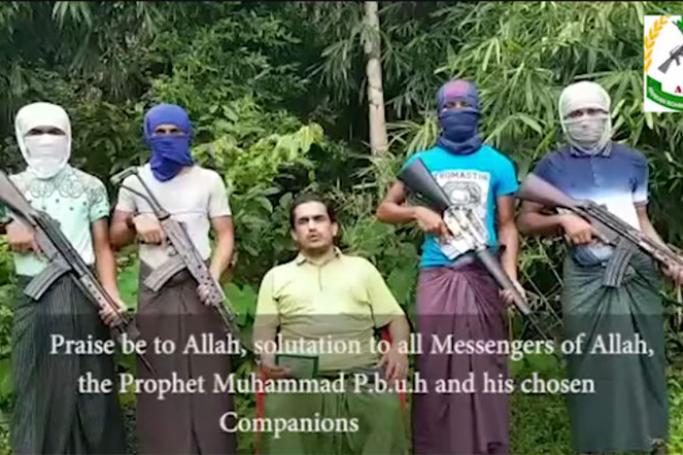Is it mere coincidence that the Arakan Rohingya Salvation Army (ARSA) went on a huge pre-dawn offensive attacking 19 police stations and one army camp in Northern Rakhine barely six hours after former UN Secretary General Kofi Annan presented his Rakhine Commission report on Thursday?
The ARSA has said in its Twitter message that their attack was to break the blockade by security forces of Rohingya dominated areas that forced them into "defensive action".
The message said that the blockade has reduced towns like Rathidaung and Buthidaung to "near starvation".
There is no independent corroboration of such allegations - the barring of media by the Myanmar authorities has made it impossible to check on that.
But while there could be some truth in allegations that the Tatmadaw was blocking food supplies, why did the ARSA have to wait to launch the attacks -- the biggest since October -- until Kofi Annan had presented his Rakhine commission report to the President and State Counselor and addressed the media conference?
The coincidence is too striking to be overlooked.
The Annan report,made public with its strong conclusions, internationalised the Rakhine State issue in a big way. It was covered across the world as journalists from the major global media were present at the media conference at the Sule Shangrila Hotel in Yangon on Thursday evening. The press especially in Muslim-predominant countries covered the event in a big way.
The ARSA had surely planned the strike if what they say is to be believed. If the northern Rakhine 'blockade' was the cause behind the pre-dawn offensive, the timing was clearly influenced by the Annan Committee report going public.
They decided to garner greater attention to their cause after the Kofi Annan report had brought them some global notice.
Such an extensive attack, carried out in the middle of a military campaign in the Mayu mountains, would have taken time to plan. The mobilisation of so many fighters would not be easy to conceal unless done with great care and deception. So though the planning had been done for a while, a few weeks if not months, the ARSA would have decided to wait for Kofi Annan to make public his report.
As some residents of Maungdaw and Buthidaung have indicated, a lot of armed villagers joined the ARSA rebels in the offensive, if only with sharp weapons like machetes.
The Maoists in India, rebels in Indian Kashmir and Taliban in the Afghanistan-Pakistan region use angry villagers to join their core hit squads to (a) boost numbers needed for a deadly second sweep on the targets, (b) conceal rebel formations by ringing them with villagers, and (c) project the political mass base of the guerilla group.
It seems the ARSA, who have received military training in Pakistan and ideological training from some hardline Saudi clerics have adopted these massing tactics while planning a major attack like the one in October or on Friday.
Its links with Pakistan's LET is known to Myanmar intelligence. It also has links to Bangladesh's dreaded Jamaatul Mujahideen Bangladesh (JMB) responsible for last year's Holey Artisan Bakery attack in Dhaka. Some reports have also indicated that ARSA's nucleus is one small terror cell made of Rohingyas who collaborated with Indian Mujahideen to set off the Julo 2013 Bodh Gaya bombings in eastern India. That cell was allegedly shepherded by Pakistan's ISI, who then used the LET's humanitarian front Fala e Insaniyat recruit young radicalised Rohingyas .
Mizzima had exposed these links last year ( http://www.mizzima.com/news-domestic-regional/pakistan-links-rohingya-mi...).
The military operations in the Mayu mountains of Rakhine State, in which the Tatmadaw is fielding the 33rd Light Infantry Division, has forced the ARSA on the defensive .
They needed a diversionary attack to draw the security forces away from the enveloping campaign to encircle the ARSA's core base zone in the Mayu mountains by launching a major attack somewhere else.
Friday's attack on a wide area around three townships -- Maungdaw, Buthidaung and Rathedaung -- was meant to draw the forces away from the offensive operations into static deployments to guard police stations, government offices, roads, villages and other possible targets.
But it also suggests a a failure of the government's intelligence machinery (military and police) to spot the large mobilisation of guerrillas to staging posts, from where the attacks were launched.
That is something the security forces, especially the Tatmadaw, needs to worry about.
How could 1,000 armed people (not all ARSA though) be mobilised without the intelligence spotting it? That would suggest the intelligence penetration in Rohingya areas is minimal despite much resources going into it.
A complete breakdown of inter-ethnic relations can also dry up sources for intelligence -- that has happened in Kashmir or the Maoist areas of Central India and is now perhaps unfolding in the Rohingya areas of northern Rakhine.
You are viewing the old site.
Please update your bookmark to https://eng.mizzima.com.
Mizzima Weekly Magazine Issue...
14 December 2023
Spring Revolution Daily News f...
13 December 2023
New UK Burma sanctions welcome...
13 December 2023
Spring Revolution Daily News f...
12 December 2023
Spring Revolution Daily News f...
11 December 2023
Spring Revolution Daily News f...
08 December 2023
Spring Revolution Daily News f...
07 December 2023
Diaspora journalists increasin...
07 December 2023
Philippines' Duterte condemns South China Sea flare-up












